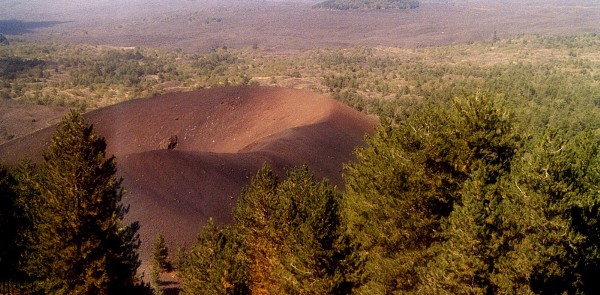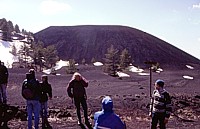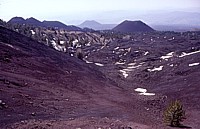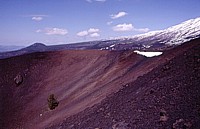| Etna
index |
||
| Geology | Geological history | Cones and craters |
| Eruptive characteristics | Eruptions before 1971 | Eruptions since 1971 |
| Etna and Man | References | Web sites |
| Weather forecasts | FAQ | Latest news |
 |
The
low, horseshoe-shaped cone of Monte Mezzaluna rises from a densely
forested area on the northern flank of Monte
Rosso, an older and much larger pyroclastic cone. The poor
vegetation on this cone and the associated lava field indicates
that both formed quite recently, and many sources ascribe them
to the 1763 eruption that formed Monte
Nuovo, about 1 km further downslope to the west. However,
the composition of Monte Mezzaluna and its lavas is different
from that of the Monte Nuovo products.
This photograph was taken from the northeastern flank of Monte
Rosso in September 2003 |
Mamma
Etna's countless children
Monte Mezzaluna
W flank, 14.93562° E, 37.74802° N
Summit elevation: 1755 m
![]()
Monte
Mezzaluna, the "half-moon mountain", has until recently been
attributed to the same eruption in February-March 1763 that also produced
the larger Monte Nuovo cone, about 1 km further to the west. However,
palaeomagnetic measurements on the lava flows emitted from Monte Mezzaluna
(Tanguy et al., 2003) show that the composition of these lavas differs
from those of Monte Nuovo, and thus it is
likely that it was produced during another eruption. The age of this eruption
is not known but probably it occurred quite recently, judging from the
youthful shape and vegetation of the cone and the associated lava field.
Yet, in the light of the most recent flank eruptions of Mount Etna, in
2001 and 2002-2003, it is not all that unrealistic that a single eruptive
event produces two different types of magma, and thus the question about
a participation of Monte Mezzaluna in the 1763 eruption remains open.
Monte Mezzaluna is a horseshoe-shaped, small (about 50 m high) cone leaning
against the NNW flank of the much larger and considerably older Monte
Rosso. Its single crater is wide open to the W, where a relatively
small quantity of lava has spilled out for a distance of about 1 km. Two
other lobes of lava, 0.7 and 0.35 km long, respectively, have extended
from the northern side of the cone, possibly in an early stage of its
activity, when the cone had not yet grown to its final dimensions. A single
pine tree has grown exactly in the center of the crater where it is relatively
protected from the frequently violent winds blowing in the area.
I visited and climbed Monte Mezzaluna in April 1997, when most of the
photographs shown on this page were taken; however, the lighting conditions
were unfavorable (partially due to very sharp contrasts when I already
used a high-contrast film) and the quality of the photographs is unusually
low.
 |
 |
|
Left:
the low cone of Monte Mezzaluna seen from east in April 1997. On
its south (left) side, the cone leans against the lower, snow-covered
north flank of the adjacent, much larger and older Monte
Rosso Center: southern crater rim of Monte Mezzaluna from south in April 1997. Note the single pine tree standing in the lower portion of the crater wall. The snow-covered flank of Etna's main edifice is seen in right background, and the cone seen in the distance at left is Monte Maletto. Photo taken in April 1997 Right: a look down into the crater of Monte Mezzaluna from its southeast rim in April 1997, showing the open west side of the crater from where a small lava flow extended for about 1 km downslope, in the direction of the symmetrical cone of Monte Nuovo (background). The single pine tree is seen in lower right corner. The Monti Di Fiore, formed in 1974, are seen in left background, and Monte Minardo is visible in the distance |
||
Copyright © Boris Behncke, "Italy's Volcanoes: The Cradle of Volcanology"
Page set up on 15 December 2003, last modified on 21 February 2004

